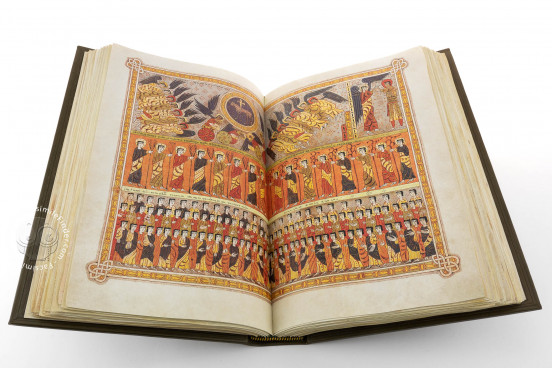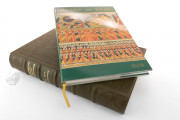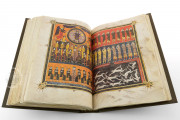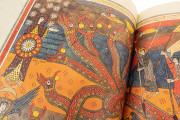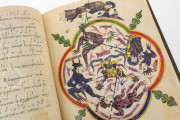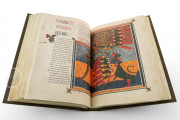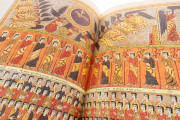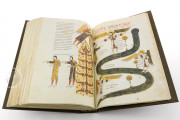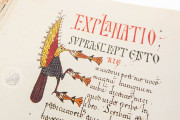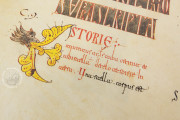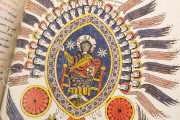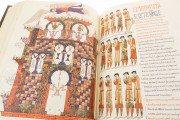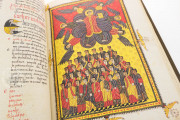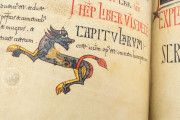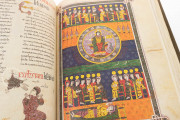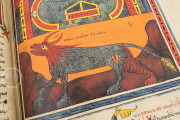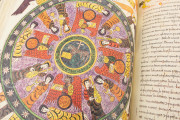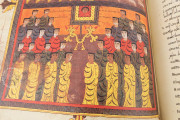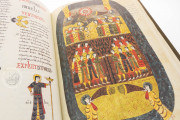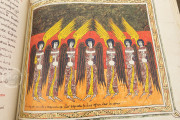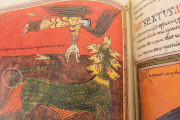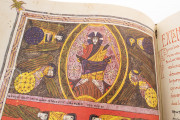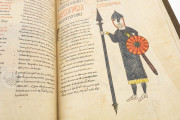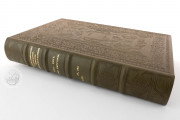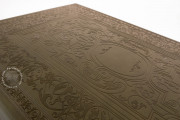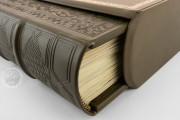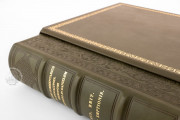The Silos Codex is one of the most richly illustrated surviving copies of Beatus of Liébana's commentary on the book of Apocalypse, the final book of the Christian Bible. It was produced at the Benedictine monastery of Santo Domingo de Silos in Spain, having been completed in 1109. The book records information about some of the makers, naming two scribes, Dominicus and Munnius, and an illuminator, the prior Petrus. The book includes fifty-three brightly colored full-page miniatures, some of which extend onto the opposite page, and an additional seventy-seven smaller pictures.
In addition to the main Beatus text, this manuscript includes a section of music for the liturgy of the Divine Office, Saint Jerome's commentary on the Old Testament book of Daniel, and other texts. Its large format, numerous lively pictures, and excellent condition make the Silos Codex one of the most important of the surviving Spanish Beatus manuscripts.
A Traditional Beatus with a Surprising Frontispiece
The Silos Codex opens with a fragmentary music manuscript probably dating from the early eleventh century (fols. 1-4), perhaps a conscious move to preserve a remnant of the Mozarabic liturgy, which was going out of use at the time the bulk of the manuscript was copied and illuminated. The illuminator Petrus added among those opening pages a spectacular full-page depiction of Hell (fol. 2r), in which Saint Michael holds a scale and observes a group of sinners being tormented by demons, two of which are labeled Beelzebub and Radamus.
Six Colophons Record Details of Production
The colophons that record the circumstances of the manuscript's production state that the book was written and illustrated at the Benedictine monastery of Santo Domingo de Silos. The project was initiated by Abbot Fortunius and completed under Abbot Johannes.
Most of the text was completed on 18 April 1091, and the illustrations were completed eighteen years later on 1 July 1109, apparently after a long hiatus. The scribes identified in one of the colophons are only two of four scribes active in the manuscript, one of whom is the named illuminator, Petrus. They all wrote in Visigothic Minuscule, the characteristic script of the Iberian Peninsula at the time. It is thought that Munnius, the first scribe to work on the manuscript, was also responsible for some of the illumination.
Removed from Spain by Joseph Bonaparte
The Silos Beatus remained at Santo Domingo until the fourteenth century. By the mid-seventeenth century, it had come into the possession of Antonio of Aragon (1618-1650). Inherited by his brother, Pascal (1626-1677), the codex was then bequeathed to the Colegio Mayor de San Bartolomé in Salamanca in 1677. In the early nineteenth century, it entered the royal collection under Charles IV (1748-1819), King of Spain.
The manuscript was purchased by the British Museum in 1840 from Joseph Bonaparte (1768-1844), who had been King of Spain from 1808 to 1813. The medieval manuscripts in the British Museum library were transferred to the British Library upon its establishment in 1973.
The current binding of green leather over boards is French and dates from the mid-nineteenth century. The foredges were gilt and the titles were added after the manuscript entered the British Museum.
_____
For more information on the Beatus model, read our blog article by Amy R. Miller (PhD, Medieval Art History, University of Toronto).
We have 1 facsimile edition of the manuscript "Beatus of Liébana - Silos Codex": Beato de Liébana, Códice de Santo Domingo de Silos facsimile edition, published by M. Moleiro Editor, 2001-2003
Request Info / Price

